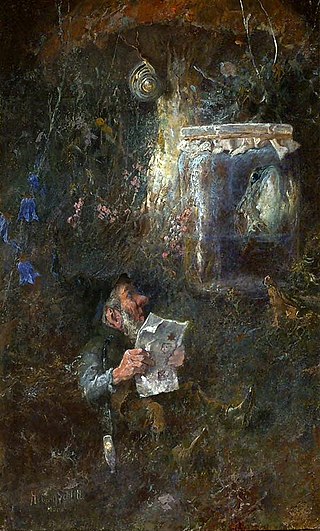
A gnome is a mythological creature and diminutive spirit in Renaissance magic and alchemy, introduced by Paracelsus in the 16th century and widely adopted by authors including those of modern fantasy literature. Typically small humanoids who live underground, gnome characteristics are reinterpreted to suit various storytellers and artists.
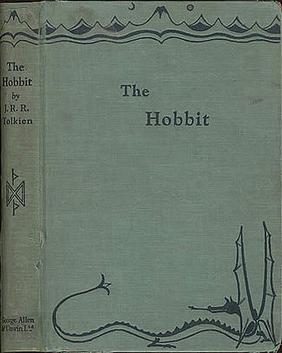
The Hobbit, or There and Back Again is a children's fantasy novel by English author J. R. R. Tolkien. It was published in 1937 to wide critical acclaim, being nominated for the Carnegie Medal and awarded a prize from the New York Herald Tribune for best juvenile fiction. The book is recognized as a classic in children's literature, and is one of the best-selling books of all time with over 100 million copies sold.

A fairy is a type of mythical being or legendary creature found in the folklore of multiple European cultures, a form of spirit, often described as metaphysical, supernatural, or preternatural.
Magical creatures are an aspect of the fictional Wizarding World contained in the Harry Potter series and connected media originally created by British author J. K. Rowling. Throughout the seven main books of the series, Harry and his friends encounter many of these creatures on their adventures in Hogwarts, the Forbidden Forest, or other locations throughout the Wizarding World. In addition, students learn to take care of creatures such as hippogriffs and unicorns in the Care of Magical Creatures class at Hogwarts. Rowling has also written Fantastic Beasts and Where to Find Them, a guide to the magical beasts found in the series, and based on the fictional textbook of the same name written by Newt Scamander and used by students at Hogwarts.
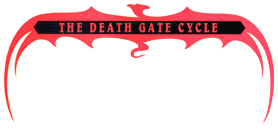
The Death Gate Cycle is a seven-part series (heptalogy) of fantasy novels written by Margaret Weis and Tracy Hickman. The main conflict is between two powerful races, the Sartan and the Patryns, which branched off from humans following a nuclear/anti-matter holocaust. Centuries prior to the events of the series, the Sartan attempted to end the conflict by sundering the Earth into four elemental realms, and imprisoning the Patryns in a fifth prison world, the Labyrinth. The Sartan took up stewardship of the elemental realms, but soon mysteriously lost contact with each other and disappeared. Centuries later, a Patryn known as Xar escaped the Labyrinth, and started returning to the Labyrinth to rescue others. He learned how to access the other worlds, using the eponymous portal called the Death Gate, and dreamed of freeing all his people from the Labyrinth and conquering the other worlds. The books follow the fiercely independent Haplo, a Patryn agent sent to scout the elemental worlds and throw them into chaos in preparation for his Lord's conquest of them. Weis and Hickman created five distinct fantasy worlds during the course of the series, along with developing the cultures of five major races: the unique Patryn and Sartan, and the common fantasy races of dwarves, elves, and humans.
Birthright is a Dungeons & Dragons campaign setting that was first released by TSR in 1995. It is based on the continent of Cerilia on the world of Aebrynis, in which the players take on the role of the divinely-empowered rulers, with emphasis on the political rulership level of gameplay. The setting revolves around the concept of bloodlines: divine power gained by heroes and passed to their descendants. Characters with a bloodline create an aura of command known as Regency, which is measured in the game using regency points or RP. Using regency, characters acquire a domain composed of provinces and holdings. The development of these domains is as much a part of the game as development of the characters. The game uses three-month domain turns to model actions of rulers over nations in much the same way as Dungeons & Dragons uses combat rounds to simulate time to model the characters' actions in battle. In 1996, Birthright won the Origins Award for Best Roleplaying Supplement of 1995.

The Spiderwick Chronicles is a series of children's fantasy books by Tony DiTerlizzi and Holly Black. They chronicle the adventures of the Grace children, twins Simon and Jared and their older sister Mallory, after they move into the Spiderwick Estate and discover a world of fairies that they never knew existed. The first book, The Field Guide, was published in 2003 and then followed by The Seeing Stone (2003), Lucinda's Secret (2003), The Ironwood Tree (2004), and The Wrath of Mulgarath (2004). Several companion books have been published including Arthur Spiderwick's Field Guide to the Fantastical World Around You (2005), Notebook for Fantastical Observations (2005), and Care and Feeding of Sprites (2006). A second series, entitled Beyond the Spiderwick Chronicles, includes The Nixie's Song (2007), A Giant Problem (2008), and The Wyrm King (2009).

In many works of modern fantasy, elves are depicted as a race or species of pointy-eared humanoid beings. These depictions arise from the álfar of Norse mythology influencing elves in fantasy as being semi-divine and of human stature, whose key traits are being friendly with nature and animals. However, this differs from Norse and the traditional elves found in Middle Ages folklore and Victorian era literature.

The Palladium Fantasy Role-Playing Game is a game produced by Palladium Books. It is set in the Palladium world some 10,000 years after a great war between the elves and dwarves. First published in July 1983 as The Palladium Role-Playing Game, the Palladium Fantasy Role-Playing Game saw a second edition in April 1996. The two are largely compatible, though the second edition uses a later iteration of Palladium's ruleset to be more compatible with the rest of their Megaverse.
Midnight is a campaign setting for the Dungeons & Dragons role-playing game, released under the Open Gaming License. It was published by Fantasy Flight Games from 2003 to 2009.

Dungeon Siege II: Broken World is the expansion pack for the role-playing video game Dungeon Siege II and continues the unfinished plot of the previous game. It was developed by Gas Powered Games and published by 2K in 2006.
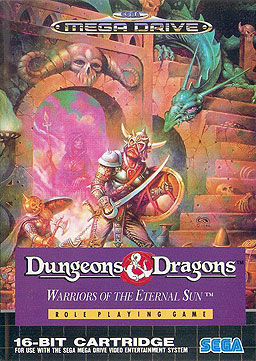
Dungeons & Dragons: Warriors of the Eternal Sun is a role-playing video game developed for the Sega Genesis in 1992 by Westwood Associates. The game tells the story of a party of adventurers who have been transported to an unknown world and must survive against its hostile inhabitants while learning about their new home and seeking allies. It is based on the Dungeons & Dragons (D&D) game rules, and uses creatures and themes from the D&D Hollow World campaign setting, such as Blacklore elves, the Azcans, beastmen, Malpheggi lizardmen, and dinosaurs.
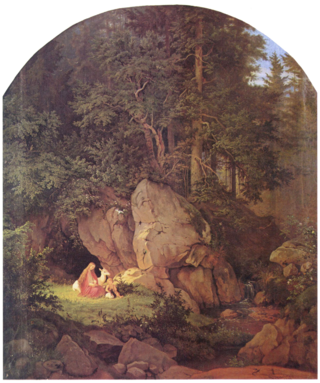
In folklore and fantasy, an enchanted forest is a forest under, or containing, enchantments. Such forests are described in the oldest folklore from regions where forests are common, and occur throughout the centuries to modern works of fantasy. They represent places unknown to the characters, and situations of liminality and transformation. The forest can feature as a place of threatening danger, or one of refuge, or a chance at adventure.
Mythic humanoids are legendary, folkloric, or mythological creatures that are part human, or that resemble humans through appearance or character. Each culture has different mythical creatures that come from many different origins, and many of these creatures are humanoids. They are often able to talk and in many stories they guide the hero on their journey.

The Southern Vampire Mysteries, also known as The True Blood Novels and The Sookie Stackhouse Novels, is a series of books written by bestselling author Charlaine Harris. The first installment, Dead Until Dark (2001), won the Anthony Award for Best Paperback Mystery in 2001 and later served as the source material for the HBO drama series True Blood (2008–2014). The book series has been retronymed the True Blood Series upon reprinting, to capitalize on the television adaptation.
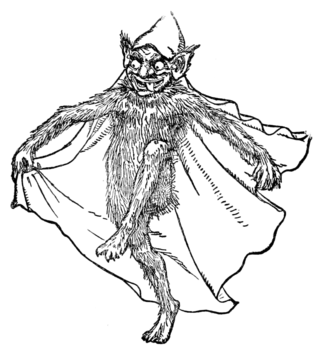
A goblin is a small, grotesque, monstrous creature that appears in the folklore of multiple European cultures. First attested in stories from the Middle Ages, they are ascribed conflicting abilities, temperaments, and appearances depending on the story and country of origin, ranging from mischievous household spirits to malicious, bestial thieves. They often have magical abilities similar to a fairy or demon, such as the ability to shapeshift.

Magicka 2 is an action-adventure video game, the sequel to Magicka, for Microsoft Windows, Mac OS X, Linux and PlayStation 4. It was released on May 26, 2015 and was announced at Sony's E3 2014 media briefing with a trailer. Instead of being developed by Arrowhead Game Studios, the title was developed by Pieces Interactive alongside the publisher Paradox Interactive.
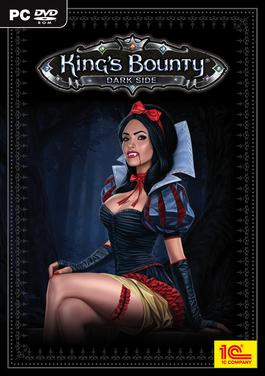
King's Bounty: Dark Side is a 2014 strategy video game developed for Microsoft Windows by 1C-Softclub and published by 1C Company. The game was released on August 14, 2014. It is a standalone installment in the King's Bounty series.
SpellForce is a real-time strategy and role-playing series created by Phenomic and currently owned by THQ Nordic. The first release was published by JoWooD Productions and Encore Software in 2003 and THQ Nordic in 2017.
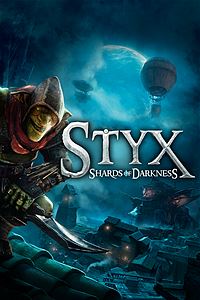
Styx: Shards of Darkness is a stealth video game developed by French developer Cyanide and published by Focus Home Interactive. The game was released worldwide on 14 March 2017 for Microsoft Windows, PlayStation 4, and Xbox One. It is the sequel to the 2014 game Styx: Master of Shadows, and the third game set in the fictional world of the Of Orcs and Men series.















